#polyamory education
Text
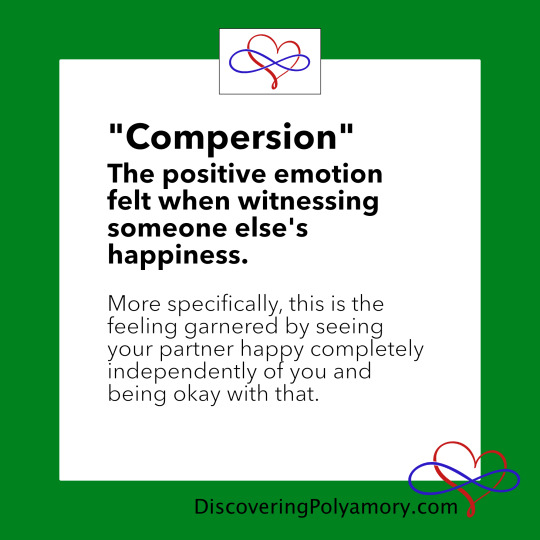
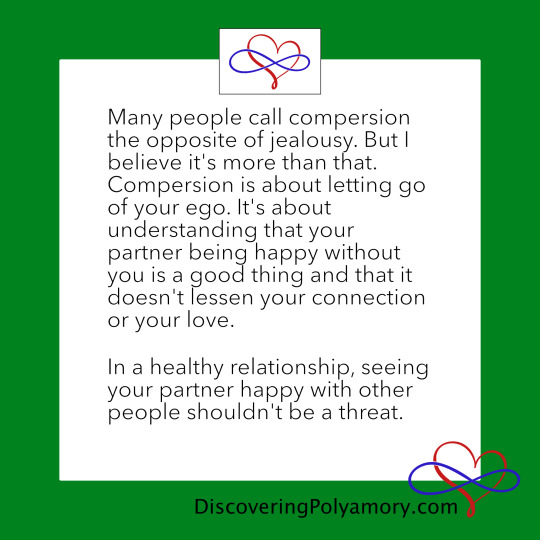
"Compersion"
The positive emotion felt when witnessing someone else's happiness.
More specifically, this is the feeling garnered by seeing your partner happy completely independently of you and being okay with that.
Many people call compersion the opposite of jealousy. But I believe it's more than that. Compersion is about letting go of your ego. It's about understanding that your partner being happy without you is a good thing and that it doesn't lessen your connection or your love.
In a healthy relationship, seeing your partner happy with other people shouldn't be a threat.
(Discover more at DiscoveringPolyamory.com)
#polyamory#polyamory advice#polyamory education#polyamory words#words#compersion#polyamorous#polyamorous relationships#better polyamory#better relationships#relationships#ethical relationships#relationship advice#relationship education#open relationships#modern relationships#green#ethical non monogamy#non monogamy#enm#polyam#poly#infinity heart#Discovering Polyamory#jealousy#love#dating#marriage
54 notes
·
View notes
Text
8 common types of polyamory:
Triad
Quad
Vee
Solo
Polycule
Hierarchical
Anchor Partners
Parallel
#polyamory#polyam#polycule#polyfidelity#vee#triad#relationship anarchy#non monogamy#alternative relationships#open relationship#relationships#definition#nowyouknow#educating#learnpolyamory#polyamorous
102 notes
·
View notes
Text
Rules vs Agreements vs Boundaries
I see these confused a lot, so here’s a simple guide to them!
Rules:
Rules are things put in place to control someone else’s behavior, whether that be a partner, a metamour, or anyone else. (Yes, it’s still a rule if you have to follow it too). Rules are strict and breaking them always has some kind of punishment involved. The punishment can be anything, maybe something decided in advance (If you do X, I’ll do Y), or even just the fight you’ll get into when it’s broken. Some examples of rules in non-monogamous relationships are:
1. You can only be with people as long as I approve, and you have to dump them if I say so (veto power)
2. We can only date cis women (one-penis-policy)
3. We have to spend at least 4 nights a week together
4. No sleeping with someone else unless I’ve met them first
5. Always be home by 11:00 PM
Now, it is possible to have healthy rules in a relationship, don’t get me wrong. However, it’s also common for rules to cause resentment and mistrust in relationships. Before making a rule, please consider where you are coming from with the rule. Most rules come from places of fear, mistrust, or insecurity. You may be making assumptions about how your partner will treat you without the rule in place, assuming the worst. Once you identify the feeling behind a proposed rule, you can attack the problem at its source instead of using a rule to cover it up. It’s similar to jealousy, in that respect. If you and your partner agree the rule comes from a good and constructive place, then you have a good rule.
Agreements:
Agreements are the hardest to pin down and describe, in my opinion. Agreements are trusting each other and acknowledging each other’s needs and your commitment to meeting those to the best of your abilities. Multiamory describes the difference between the philosophy of agreements and rules as, “A philosophy of communication and trust, as opposed to a philosophy of restriction and requirement”. Please remember that the philosophy and intent behind what you and your partner agree to is more important than the language used. Regardless of whether you call it a rule or an agreement, it’s the intent that makes it healthy or unhealthy. Possible agreement alternatives to the rule examples are:
1. We will trust each other’s judgment in our other relationships, and we’ll be aware of and work through any jealousy they cause
2. We will work together to unpack the insecurities the one who set the rule had, and take agreed upon baby steps towards dating other men and/or people with penises to help ease them into the change while we work through this insecurity
3. We will spend deliberate time together each week and not take our living together for granted
4. We will stay safe during sex and be open and transparent with each other about our sex practices, and we will communicate about and work through our jealousy and insecurities together
5. We will trust each other to be safe and responsible while out, and we will keep each other updated about when we will get home and if we’ll be late so not to cause worry
Boundaries:
Boundaries are things that you can enforce all on your own. They are self-empowering, unlike rules, which give all of the power to the other person. Boundaries are a healthy way to protect yourself and a staple in all relationships. Some examples of boundaries in relationships are:
1. I will not stay in a relationship with someone who is abusive
2. I will not have unprotected sex with someone who is having unprotected sex with other people
3. I will not stay in a relationship with someone who smokes
4. I will not stay in a relationship with someone who is deceptive
5. I will not share intimate details about my other relationships with my other partners unless it directly affects them and/or our sexual safety
The only issue with boundaries is how easy it is to turn them into threats. Going back to example number three, this can be turned into a threat by saying “If you don’t stop smoking, I will leave you”. This manipulative and controlling behavior, and it puts the power back into the partners hands, so it is no longer self-empowering. It stops being a boundary entirely, both because of the power shift, the intent behind it, and the fact that you’re still in the relationship. Boundaries are the final defense. If your boundary is broken and you don’t enforce it, and instead choose to turn it into a threat to control your partner, it loses everything that makes it a boundary and becomes another way to take control. You can avoid this by making sure the focus stays on you, what you’re comfortable with, and what you’ll do to take care of yourself. Always be honest with yourself about your intentions, and never be afraid to enforce a boundary. Keeping yourself safe is more important than the relationship and/or action that is compromising that.
For more information, I highly suggest the Multiamory podcast episode “Rules vs. Agreements feat. Boundaries”. It goes a little more in-depth than I did, and it was my main resource when writing this post.
#rules vs agreements vs boundaries#rules#agreements#boundaries#relationship advice#non-monogamy#nonmonogamy#enm#polyamory#polyam#polya#relationship anarchy#educational#multiamory#multiamory podcast
389 notes
·
View notes
Text

PSA for the poly community: This is so important because it’s so easy to get caught up in the emotional high when experiencing NRE (New Relationship Energy) and inadvertently make other partners feel neglected or not as important.
#queued#psa#important#poly life#polyam life#polyamarous#polyam dating#polyamory#polyam education#polyamourous#bamababygirl7🥰💞#bd/sm education
20 notes
·
View notes
Text
10.14.22
My current polyamourous relationships
Hubby- Married 16 years. Life partner. Nesting partner and partner in raising children. Hubby is aromantic but not asexual. He is not poly oriented and has no other partners.
Daddy- D/s dynamic 3.5 years. He is Daddy and Master. I am submissive and little. Lives six hours away and is now fully a long distance partner. Romantic and sexual partner. Helps me push physical and mental boundaries. Deeply bonded. He has one platonic partner who is long distance.
J- Platonic partner. Friends for 5+ years. Emotional support in all aspects of life from parenting to balancing a polyamourous life. Long distance. J has two romantic and sexual partners.
48 notes
·
View notes
Text
Can anyone point me in the direction of some good poly blogs/references? It may very well be in my immediate future, and Everytime I search it I just get threesome shit lol
5 notes
·
View notes
Text
The funniest people to me are those who're so desperately trying to badmouth polygamy.
"People in poly relationships don't love each other."
"It's just an excuse to cheat."
"Who wouldn't wanna screw two girls at once?"
"If you love someone and fall in love with another, you don't truly love them."
This just goes to show how little these people know about poly relationships and how fragile their own relationships are. Being poly is a damn lot of work and requires absolute trust in one another. You need to be perfectly open about yourself and your desires, you need to communicate and you need to be able to spot problems and edges in your relationships before they turn into a problem. Poly people love deeper than you can imagine. It's a level of closeness and faith in each other only a small portion of monogamous couples ever experience.
We don't have multiple partnes because we want to f*ck around and have fun. And we don't choose our partners easily. It requires a lot of thought and takes even more time to find someone that truly fits into your ribbon of souls. We are deeply dedicated to our partners and do our best to pamper them as much as we can. It is an exchange of love and comfort, of light and fun. We don't possess each other and don't keep our partners behind our bars to a point where we grow so jealous and afraid of contenders that we turn into poison. In fact, we love so openly and so much that a single person simply isn't enough.
This doesn't mean one partner is worth less to us than the other or that we need an escape from the relationship with our other partner. Nor does it entail all of our partners to also be in a relationship with each other. Polygamy is as fluid and wild as the sea, as every sea has its own color, flora and fauna.
Now, I in no way, shape or form am saying polygamy is the best or that other relationship structures are bad. Everyone has the right to love how and who they want. But denouncing us and saying things like "What has our world come to?" is just straight up rude. Polygamy has been practiced for as long as humanity exists, and I'm not talking about harems. All I'm saying is that I've seen enough toxic monogamous relationship to sit back and swallow these accusations.
3 notes
·
View notes
Text
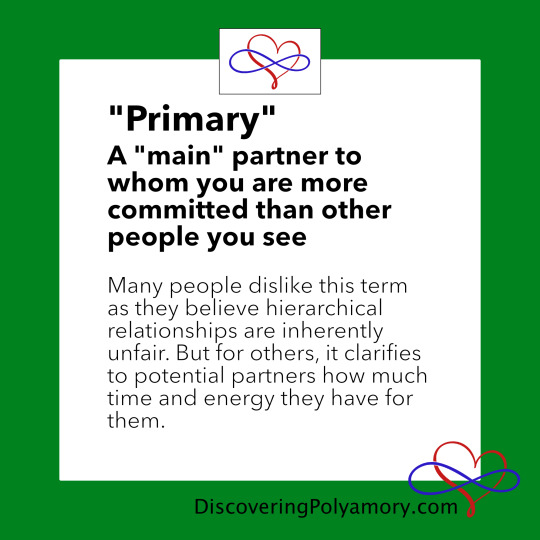

"Primary"
A "main" partner to whom you are more committed than other people you see
Many people dislike this term as they believe hierarchical relationships are inherently unfair. But for others, it clarifies to potential partners how much time and energy they have for them.
This term is often used by couples who have opened up to polyamory together. When you share things with one partner, such as home ownership or childrearing, they will often, by necessity, have to take priority over others.
(Discover more at DiscoveringPolyamory.com)
#polyamory#polyamorous advice#polyamory advice#polyamory education#polyamory pride#polyamorous#polyamorous relationships#open relationship#modern relationships#open relationships#ethical relationships#relationships#relationship advice#relationship education#ethical non monogamy#non monogamy#enm#poly#polyam#discovering polyamory#polyamory terms#polyamory words#love#dating#marriage#green#primary#primary relationship#infinity heart
47 notes
·
View notes
Text

Its 79 and cloudy here in the North Georgia mountains. Whats the weather like outside where you live?
#anxitey#artists on tumblr#friends#gay#goth girl#polyamourous#witchlife#education#funny#illustration#polyamory#girls who like girls#girls with tattoos#new friends
3 notes
·
View notes
Text
welcome to my blog!

hello love! welcome to my tumblr blog! here, I will post headcanons / one shots / collages for several fandoms and you guys can request them!
⋆ ˚。⋆୨୧˚
here's a little something about me:
16 yrs old / she!her / hufflepuff / I love hyperfixating on any show that I'm watching atm / bi / I'm a sucker for pop, indie, indie folk
⋆ ˚。⋆୨୧˚
request guidelines
masterlist (coming soon)
( ◜‿◝ )♡
#orange is the new black#shadow and bone#harry potter#lgbtq#marvel#my account#hello tumblr#welcome#polyamory#polyamorous#orange is the new gay#orange is the new black x reader#heartstopper s2#cobra kai#sex education#anne with an e fandom#anne with an e#gossip girl#emily in paris#everything now netflix#cobra Kai#daniel larusso#karate kid#the karate kid#cobra kai x reader#one piece live action#shameless Netflix#gallavich
4 notes
·
View notes
Note
Yeah... Educate myself I shall. Growing up in a Balkan country already set my minds solid on a few matters on a bit, with a surprising non sensitivity to offensive topics. But, yeah, the west is different so I will educate myself on Polyamory.
That is good to hear. I myself grew up and live in Poland, but I took time to educate myself on a lot of topics. Internet is full of resources just for that <3
#re: polyamory#anon asks#in the era of the internet its easy to educate yourself#its good to use that opportunity
23 notes
·
View notes
Text
gonna make 2024 my year, trust and believe
#2023 was crazy#i had four friends (FOUR) have crushes on me 😭#one ended poorly because they asked out my other friend after we went on one date#one ended totally fine#two already had partners#and one of those two had a crisis about being polyamory in part because of me#and that's not even counting the person who broke into my apartment :(#or the breakdown i had where i realized i really cant handle romance (i think theres something broken inside of me)#so...praying that 2024 has No Drama please and thank you#i will simply...take care of my health#and i will glow up#and i will focus on my education and future#yeah...hopefully :)
0 notes
Text
season three of sex education would be a lot less fraught for maeve if the topic of polyamory were introduced
1 note
·
View note
Photo

Part 2! 15 February 2023 at 9:30 PM we will have @mitoucharlesandesanskreyol back for another show. Join us if you can. It will be streamed in the Haitian FREE Thinkers page, group, and YouTube channel. #polyamory #haitianfreethinkers #atheist #Haiti #esanskreyol #education #athees https://www.instagram.com/p/CoN4kqXrUXZ/?igshid=NGJjMDIxMWI=
1 note
·
View note
Text
Polyamory
DICTIONARY

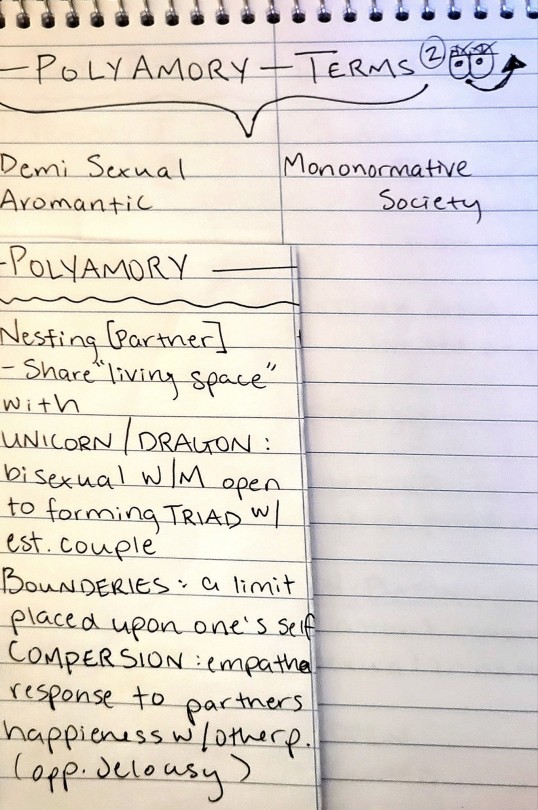
PODCASTS (Spotify)
Probably Polly
Poly Pages
Normalizing Non-Monogomy
Kinky, Nerdy, Polly
Multiamory
Polyamory Weekly
Open Late (Jessica)

NOTES
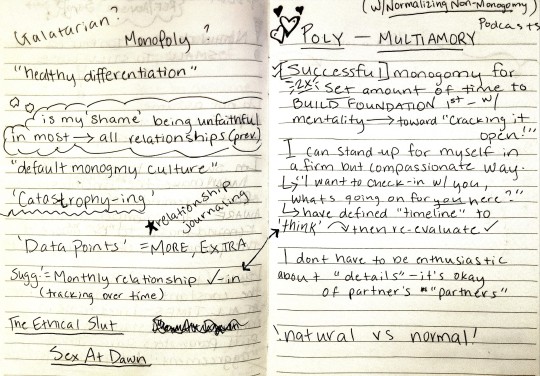
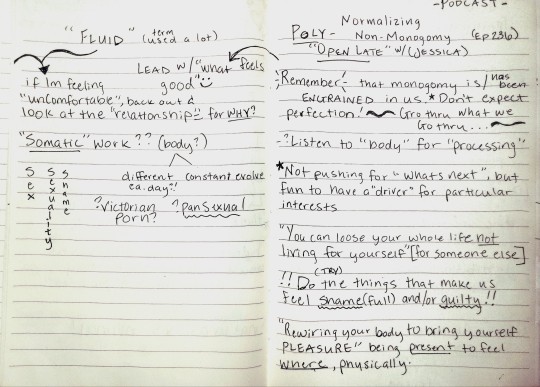
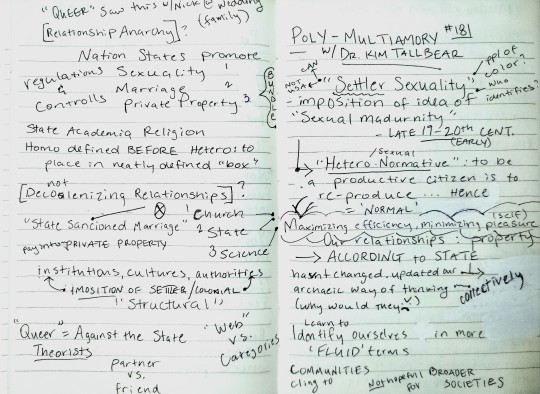

"THE ETHICAL SLUT"

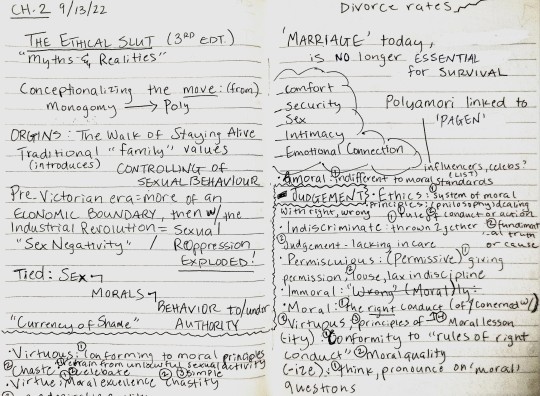

BOOKS
1 note
·
View note
Text
I watched the asexual and aromantic communities get eaten away at by exclusionists and proto-TERFs and queer people making fun of microlabels and people who talked about how they just wanted all of us to stop dividing ourselves so much and people who decided that the concept of the Split Attraction Model was homophobic and people who flooded the ace and aro tags with porn and--
Well, you get the point.
But now a lot of people on this site don't know about ace culture and modern history, so here's some stuff you should know about:
The Asexuality Visibility and Education Network (AVEN) was started in 2001 by asexuality activist David Jay as a forum and educational space about asexuality.
A Carnival of Aces, which is a monthly blogging carnival on ace topics, has been taking place since May 2011 and has included such topics as coming out, non-traditional relationships styles and polyamory, asexual education (which I hosted), and labels and microlabels.
The Split Attraction Model is one model for talking about sexual and romantic orientation that splits out those two orientations, allowing individuals to describe sexual attraction/orientation as distinct from romantic orientation (e.g., aromantic bisexual, heteroromantic grey-asexual). While this model is primarily used by people on the ace and aro spectrums, it can be used by anyone who wants to discuss or describe sexual orientation as being separate from romantic orientation.
The AVEN triangle (or asexuality triangle) is a black and white or greyscale triangle that originated from taking the Kinsey scale and extending it down into another axis to address/acknowledge the range of attraction between what's on the Kinsey scale (allosexuality) and no sexual attraction (asexuality). It's generally presented as white at the horizontal line at the top and then black at the point at the bottom, often with a gradation of shades of grey down to the bottom.
Microlabels are specific (sometimes very narrow) labels for sexualities, romantic orientations, and genders. While these are not aro- or ace-specific, they were often associated with those communities because there was a culture of having nuanced conversations about narrow definitions, often by people couldn't find something that fit their experience in the standard L, G, B, or T lexicon. Demiromantic/demisexual, cupioromantic/cupiosexual, and quoiromantic/quoisexual are all examples of micro-labels.
The ace ring, a black ring worn on the middle finger of the right hand (generally) is a symbol of asexuality that some ace people wear. It originated on AVEN in 2005 when people were looking for a symbol that was rather covert.
Cake has also been an ace symbol, mostly from the idea that ace people agree that cake is better than sex. It used to be common to see a drawing of a cake with the ace flag colors.
The ace of (heart/spades/clubs/diamonds) has at times been used as a symbol for different ace spectrum/aro spectrum combinations. Ace of hearts is generally agreed on as alloromantic asexual and ace of spades as aromantic asexual (aroace or aro/ace). Ace of clubs is sometimes for grey-romantic asexual and ace of diamonds sometimes for demiromantic asexual, but those are less common.
Dragons were also associated with the ace community, at least on Tumblr. I'm less certain where this one came from (theories include that they're mythological creatures the way ace people are seen to be or that it's because there were headcanons that Charlie Weasley was ace).
6K notes
·
View notes